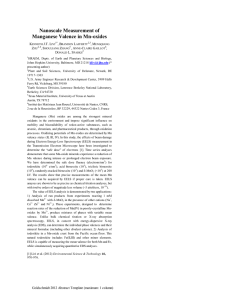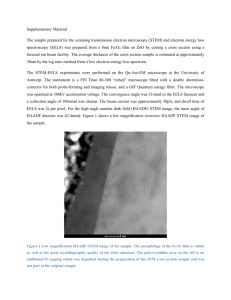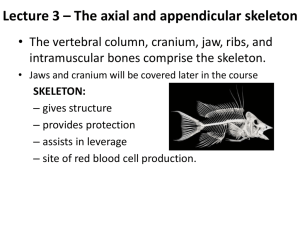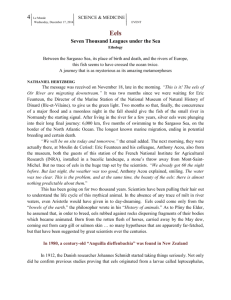bonytongues to herrings
advertisement
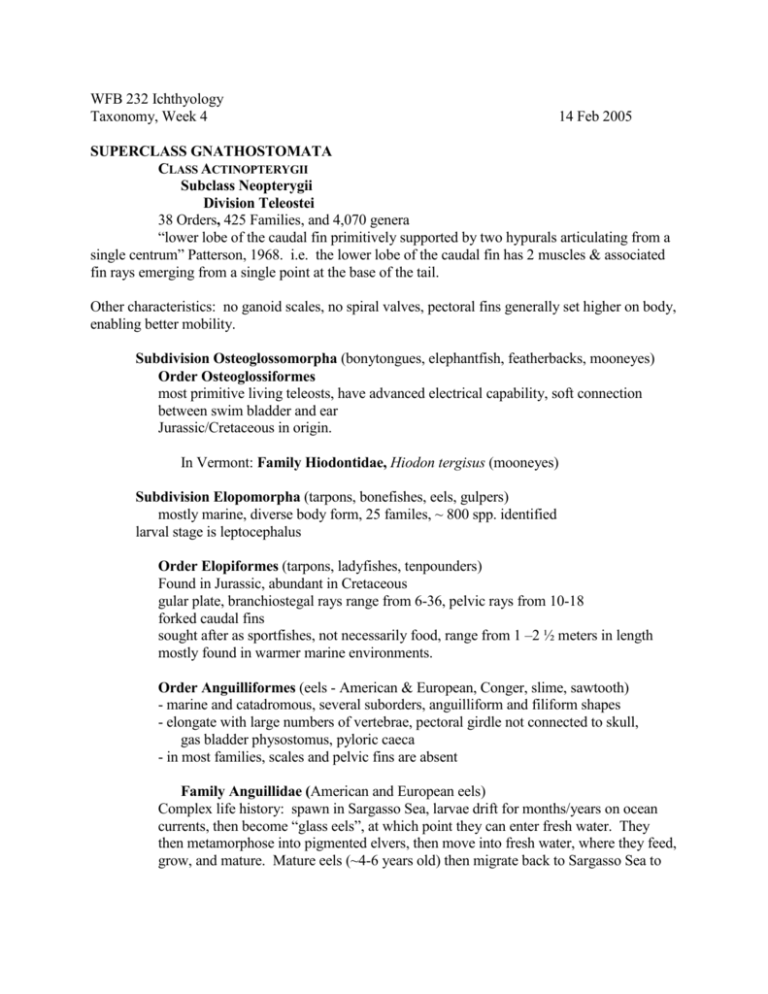
WFB 232 Ichthyology Taxonomy, Week 4 14 Feb 2005 SUPERCLASS GNATHOSTOMATA CLASS ACTINOPTERYGII Subclass Neopterygii Division Teleostei 38 Orders, 425 Families, and 4,070 genera “lower lobe of the caudal fin primitively supported by two hypurals articulating from a single centrum” Patterson, 1968. i.e. the lower lobe of the caudal fin has 2 muscles & associated fin rays emerging from a single point at the base of the tail. Other characteristics: no ganoid scales, no spiral valves, pectoral fins generally set higher on body, enabling better mobility. Subdivision Osteoglossomorpha (bonytongues, elephantfish, featherbacks, mooneyes) Order Osteoglossiformes most primitive living teleosts, have advanced electrical capability, soft connection between swim bladder and ear Jurassic/Cretaceous in origin. In Vermont: Family Hiodontidae, Hiodon tergisus (mooneyes) Subdivision Elopomorpha (tarpons, bonefishes, eels, gulpers) mostly marine, diverse body form, 25 familes, ~ 800 spp. identified larval stage is leptocephalus Order Elopiformes (tarpons, ladyfishes, tenpounders) Found in Jurassic, abundant in Cretaceous gular plate, branchiostegal rays range from 6-36, pelvic rays from 10-18 forked caudal fins sought after as sportfishes, not necessarily food, range from 1 –2 ½ meters in length mostly found in warmer marine environments. Order Anguilliformes (eels - American & European, Conger, slime, sawtooth) - marine and catadromous, several suborders, anguilliform and filiform shapes - elongate with large numbers of vertebrae, pectoral girdle not connected to skull, gas bladder physostomus, pyloric caeca - in most families, scales and pelvic fins are absent Family Anguillidae (American and European eels) Complex life history: spawn in Sargasso Sea, larvae drift for months/years on ocean currents, then become “glass eels”, at which point they can enter fresh water. They then metamorphose into pigmented elvers, then move into fresh water, where they feed, grow, and mature. Mature eels (~4-6 years old) then migrate back to Sargasso Sea to spawn. Reach ~ 1 meter in length. Other species (A. japonica) in Asia spawn in areas similar to the Sargasso, with similar life cycles. In Vermont: American eel (Anguilla rostrata) Order Saccopharyngiformes (gulpers and swallowers) eel-like fishes of deep marine waters lack maxilla, premaxilla, opercular bones and branchiostegals hyomandibular projects backward, elongating the mouth some lack gas bladders, scales, & ribs, caudal & pelvic fins are reduced/absent mouth can be 3-7 times as long as the cranium feed on other fishes, some species have bioluminescent organs Subdivision Clupeomorpha Order Clupeiformes (herrings and anchovies) Jurassic Period gas bladder extends into inner ear, soft rays, silvery deciduous scales (cycloid) planktivorous, lack gular plate harvested around the world – anchovies in Peru Family Clupeidae (herrings, shads, sardines) 20 million metric tons harvested annually marine, anadromous & freshwater compressiform, teeth small/absent In Vermont: American shad (Alosa sapidissima) Alewife (Alosa pseudoharengus) Blueback herring (Alosa aestivalis) Gizzard shad (Dorosoma cepedianum)


